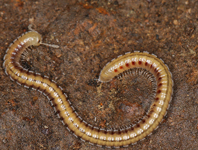Abstract
Two new species of Bleekeria Günther, 1862 are described from specimens collected in the Andaman Sea off the coast of Myanmar during bottom surveys conducted by the R/V Dr Fridtjof Nansen in 2015 and 2018. They are distinguished from each other and from congeners by a combination of morphological and meristic characters as well as fin coloration and genetic variance. Bleekeria albicauda sp. nov. has pelvic fins, 40–41 dorsal-fin rays, 54–55 total vertebrae, no teeth in jaws, 4 scale rows between dorsal-fin origin and lateral line, a single row of about 10 scales on mid-upper part of opercle, scales on central part of body clearly shorter than their height, caudal fin with white upper and lower lobes when fresh (unique within the genus). Bleekeria nigrilinea sp. nov. has no pelvic fins, 37–39 dorsal-fin rays, 49–50 total vertebrae, 2½ scale rows between dorsal-fin origin and lateral line (the smallest count within the genus with B. estuaria of Mozambique brackish water), 5–6 scales on mid-upper part of opercle arranged in a single row, scales on central part of body clearly longer than their height, upper and lower margins of caudal fin black when fresh (unique within the genus). The COI gene sequences of the two new species showed clear genetic divergence (pairwise K2P, >10 %) from Bleekeria estuaria Randall & Ida, 2014 and Bleekeria mitsukurii (Jordan & Evermann, 1902). A key to the species of Bleekeria is provided.
References
Akhilesh, K.V., Yousuf, K.S.S.M., Kizhakudan, S.J. & Zacharia, P.U. (2019) Redescription of Bleekeria kallolepis (Actinopterygii: Perciformes: Ammodytidae) from Chennai, eastern Indian Ocean. Acta Icthyologica et Piscatoria, 49 (1), 95–99.
https://doi.org/10.3750/AIEP/02456
Chang, C.H., Shao, K.T., Lin, H.Y., Chiu, Y.C., Lee, M.Y., Liu, S.H. & Lin, P.L. (2017) DNA barcodes of the native ray-finned fishes in Taiwan. Molecular Ecology Resources, 17, 796–805.
https://doi.org/10.1111/1755-0998.12601
Ida, H., Sirimontaporn, P. & Monkolprasit, S. (1994) Comparative morphology of the family Ammodytidae, with description of two new genera and two new species. Zoological studies, 33 (4), 251–257.
Fricke, R., Eschmeyer, W.N. & Van der Laan, R. (Eds.) (2020) Eschmeyer’s catalog of fishes: genera, species, references. Available from: http://researcharchive.calacademy.org/ichthyology/catalog/fishcatmain.asp (accessed 13 March 2020)
Joshi, K.K., Zacharia, P.U. & Kanthan, P. (2012) Description of a new sand lance species, Bleekeria murtii (Perciformes: Ammodytidae) from India. Indian Journal of Fisheries, 59 (2), 101–107.
Kumar, S., Stecher, G., Li, M., Knyaz, C. & Tamura, K. (2018) MEGA X: Molecular Evolutionary Genetics Analysis across computing platforms. Molecular Biology and Evolution, 35 (6), 1547–1549.
https://doi.org/10.1093/molbev/msy096
Psomadakis, P.N., Thein, H., Russell, B.C. & Tun, M.T. (2019) Field identification guide to the living marine resources of Myanmar. FAO Species Identification Guide for Fishery Purposes. FAO and MOALI, Rome, xvii + 694 pp., 63 colour pls.
Randall, J.E. & Ida, H. (2014) Three new species of ammodytid fishes from the southwest Indian Ocean. Journal of the Ocean Science Foundation, 12, 1–11.
Stecher, G., Tamura, K. & Kumar, S. (2020) Molecular Evolutionary Genetics Analysis (MEGA) for macOS. Molecular Biology and Evolution, 37 (4), 1237–1239.
https://doi.org/10.1093/molbev/msz312
Steinke, D., Connell, A.D. & Hebert, P.D. (2016) Linking adults and immatures of South African marine fishes. Genome, 59 (11), 959–967.
https://doi.org/10.1139/gen-2015-0212
Thu, P.T., Huang, W.-C., Chou, T.-K., Van Quan, N., Van Chien, P., Li, F., Shao, K.-T. & Liao, T.-Y. (2019) DNA barcoding of coastal ray-finned fishes in Vietnam. PLoS ONE, 14 (9), e0222631.
https://doi.org/10.1371/journal.pone.0222631
Ward, R.D., Zemlak, T.S., Innes, B.H., Last, P.R. & Hebert, P.D.N. (2005) DNA barcoding Australia’s fish species. Philosophical Transactions - Royal Society. Biological Science, 360 (1462), 1847–1857.
https://doi.org/10.1098/rstb.2005.1716


